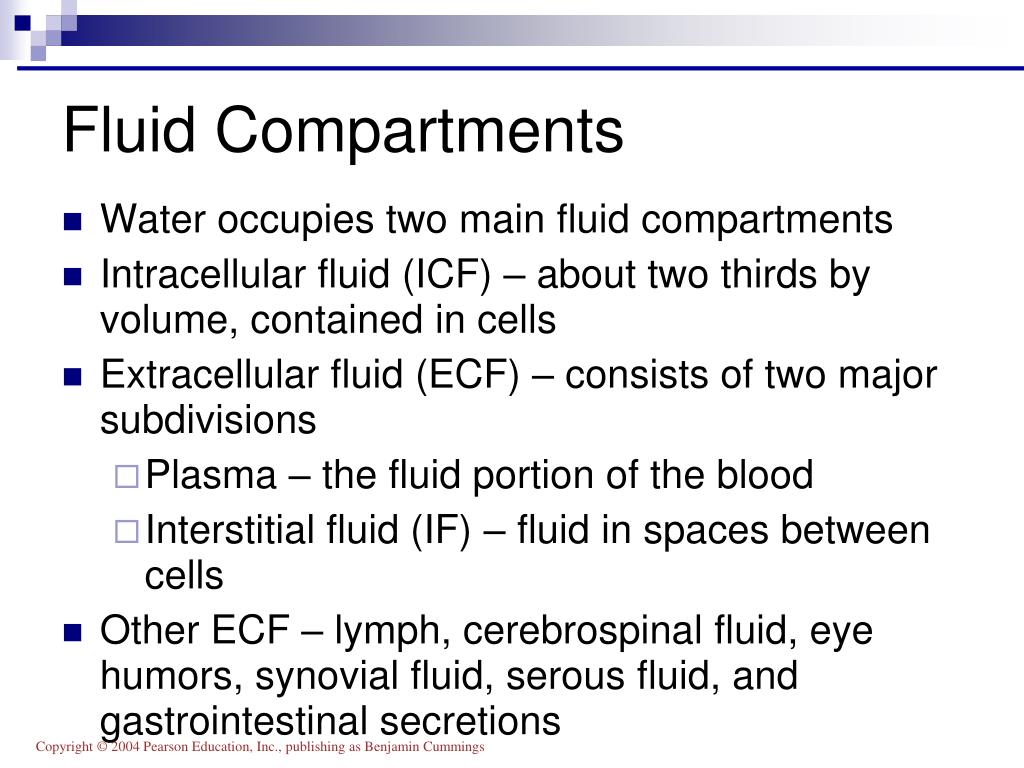

After dehydration, the subjects rested for 1 h in a thermoneutral environment (28 degrees C, less than 30% rh), after which time the changes in the body fluid compartments were assessed. Therefore, it should be remembered that both the ECF found in plasma and the ICF found in erythrocytes, contribute to the total blood volume.To investigate the influence of in sweat on the distribution of body water during dehydration, we studied 10 volunteer subjects who exercised (40% of maximal aerobic power) in the heat for 90-110 min to produce a dehydration of 2.3% body wt (delta TW). It should be pointed out that the plasma volume is not the same as the blood volume, as the volume of erythrocytes contributes nearly 40% of the entire blood's volume. As mentioned, the plasma is separated from the interstitial fluid by the vascular wall which is permeable to water and small solutes but not proteins. The plasma refers to the total volume of ECF within the vascular space.Consequently, the interstitial fluid is composed of roughly the same chemical composition as the plasma except without the proteins.
#The body fluid compartments change free
As described in microcirculatory physiology, the vasculature allows free movement of water and small solutes but not of proteins.
The Interstitial Fluid refers to the total volume of ECF outside of the blood vessels and is separated from the plasma (see below) by the walls of the body's vasculature. These compartments are separated by the vasculature. The ECF is sub-divided into two other fluid compartments known as the Interstitial Fluid and the Plasma. The ECF contains roughly one-third of the total body water or about 20% of total body weight. As mentioned before, the ECF is separated from the ICF by the plasma membrane of each cell which is impermeable to nearly all classes of solutes. The Extracellular Fluid (ECF) refers the total volume of fluid outside of cells. The ICF contains roughly two-thirds of the total body water or about 40% of total body weight. Although the plasma membrane is permeable to water, it is highly impermeable to both ionic and small solutes as well as proteins. 
The ICF is separated from the Extracellular Fluid (see below) by the plasma membrane of each, individual cell.
The Intracellular Fluid (ICF) refers to the fluid present inside cells and is considered the sum total of the fluid volume in all of the body's cells. The vascular wall is permeable to water and small solutes but not proteins. The plasma membrane is permeable to water but not small solutes or proteins. Each of these compartments is separated by the barriers shown above with unique physio-chemical properties. The ECF is itself divided between fluid within the vasculature itself, known as plasma, and that outside the vasculature, known as the interstitial fluid. The remainder is within the extracellular space as the Extracellular Fluid (ECF). Two-thirds of total body water is held within cells as Intracellular Fluid (ICF). Roughly 60% of the total body weight is water. Below we discuss how these compartments are defined, the nature of their separating barrier, and how much of the fluid volume each compartment contains in a healthy individual. In a healthy individual, fluid is divided between these functional compartments in certain ratios. Fluid within the body can be thought of as separated into several functional compartments divided by semi-permeable membranes which allow free movement of water but not of certain classes of solutes.






 0 kommentar(er)
0 kommentar(er)
